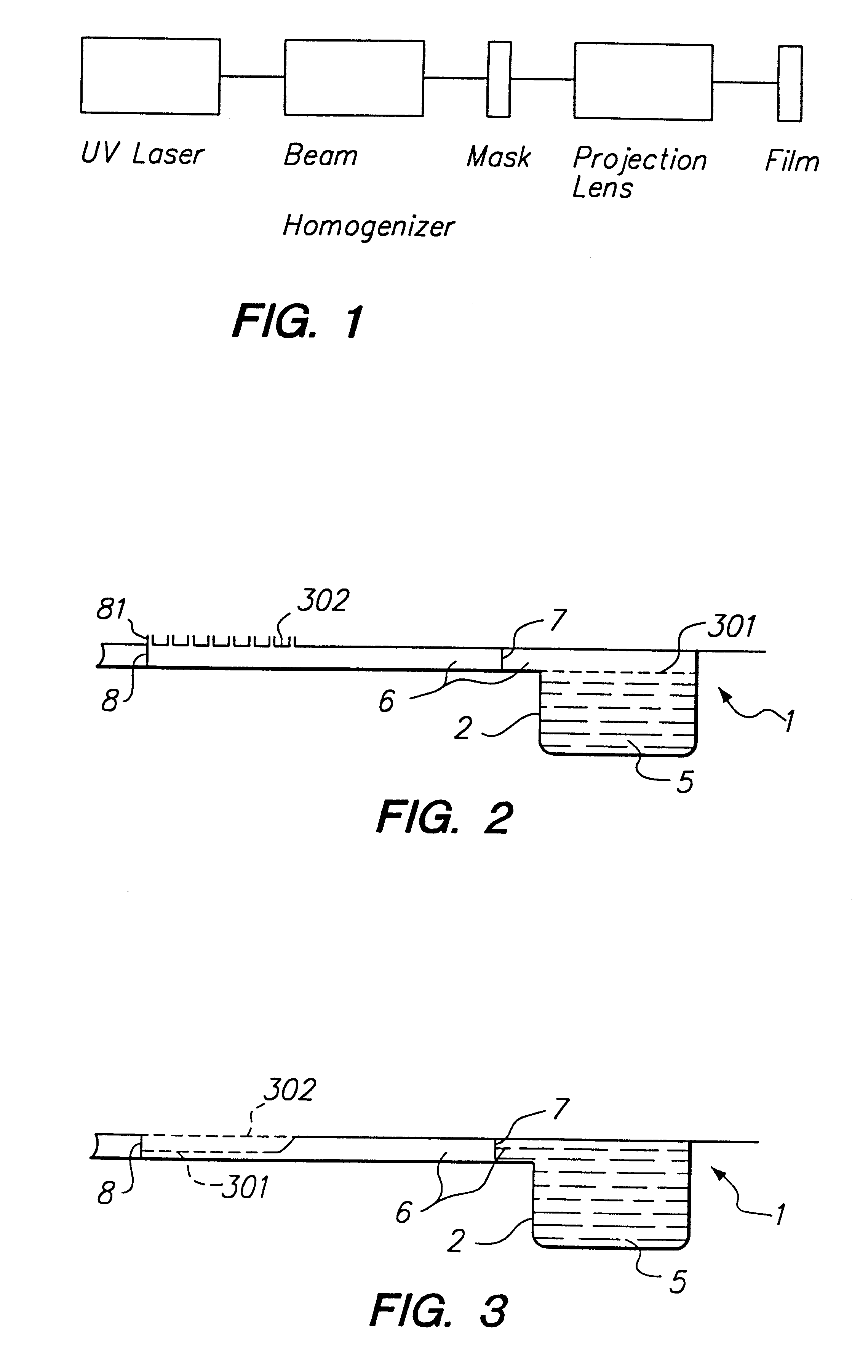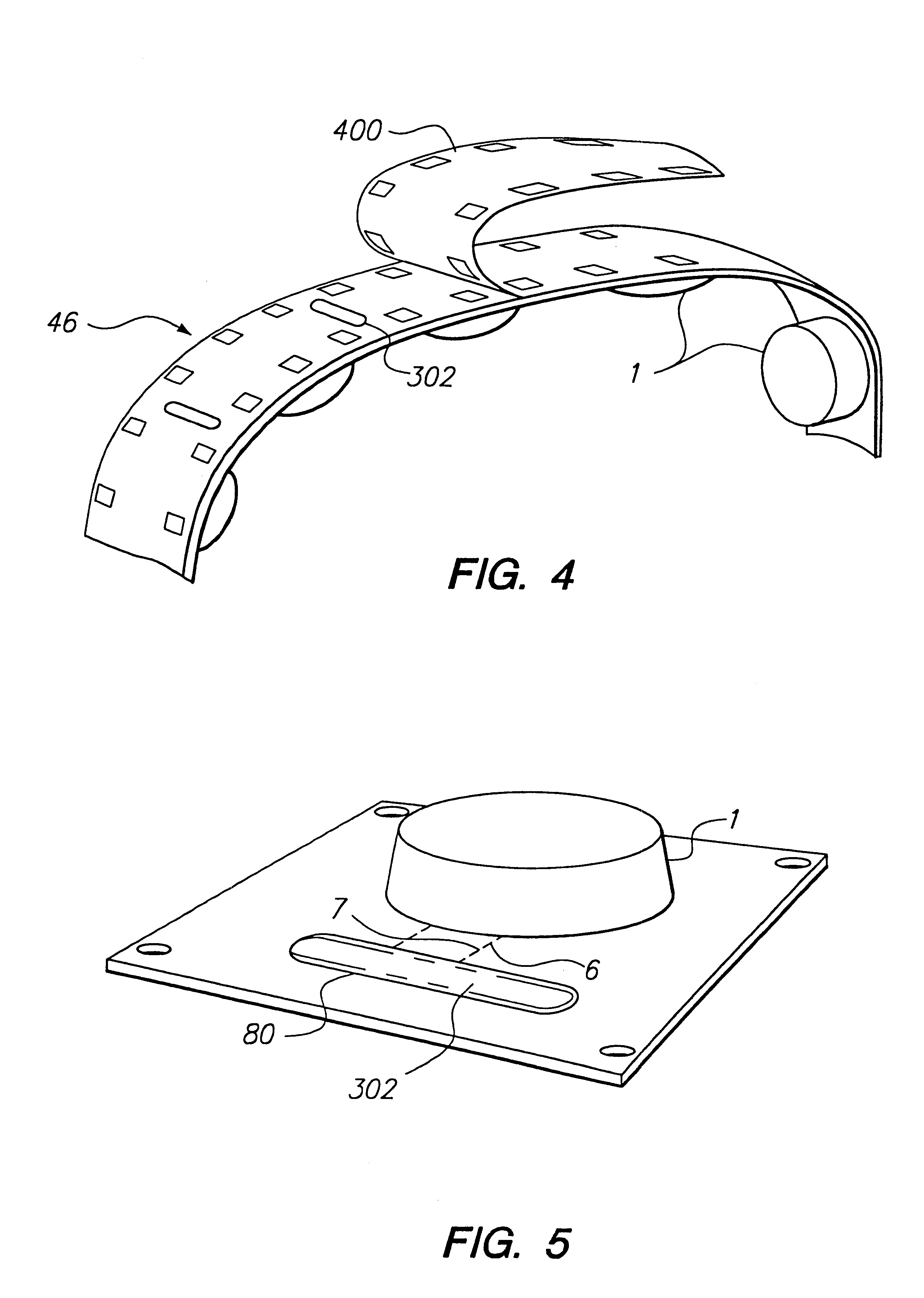Aerosol-forming porous membrane with certain pore structure
a porous membrane and pore structure technology, applied in the field of aerosol therapy, can solve the problems of difficult to reliably deliver precise doses of drugs using mdi, adverse environmental effects of propellants, inconsistent doses of patients, etc., and achieve the effect of maximizing pressure conversion and improving size distribution to the respiratory tra
- Summary
- Abstract
- Description
- Claims
- Application Information
AI Technical Summary
Benefits of technology
Problems solved by technology
Method used
Image
Examples
example 1
Preparation of Nozzles
Nozzles were prepared from thin-film polyimide (25 .mu.m, Kapton.TM. Type 100H, DuPont) using a laser (Uniphase, model s355B-100Q). The film was held by a vacuum platen to a three axis stage.
To determine the effect of power level and number of pulses on pore size, the power and pulse number was varied in a systematic fashion as pores were drilled in a single piece of Kapton. A second order polynomial fit of the pore size vs. power level was performed, and was used to estimate the power required to drill pores of diameter 1, 1.5, and 2 .mu.m. Sample nozzles were fabricated at various power levels, and pores on each sample were sized, and the average size computed. This process was iterated until a power level was determined that gave an average pore size within 5% of the desired value.
TABLE I Power Level vs Pore Size Desired Pore Size Power Level Used 1.0 .mu.m 1.1 mW 1.5 .mu.m 1.5 mW 2.0 .mu.m 1.9 mW
Nozzles for the experiments below were fabricated at these set...
example 2
Nozzles prepared as described in Example 1 were tested for generated MMAD (median size of generated aerosol), .sigma..sub.g (dispersion of the generated aerosol size distribution), and emitted dose. The nozzles were applied to AER.sub.x system disposable packages, as described in U.S. Pat. No. 5,544,646 (incorporated herein by reference), and loaded into an AER.sub.x inhaler. Nominal values for the experiment were airflow=70 liters per minute.
The MMAD of the particles prior to evaporation was measured by phase Doppler particle sizing (Aerometrics, RSA, XMT 1145, RCV 2100). Phase Doppler particle sizing uses a laser beam to scatter light from spherical aerosol particles. The scattered light is detected and analyzed to determine the particle size and velocity distribution.
The Aerometrics system was first calibrated using polystyrene latex microspheres (Duke Scientific 4205A). The particles were suspended in water, launched with a jet nebulizer (Hudson RCI, UpDraft II), and dried prior...
example 3
Purpose:
To determine the effect of variable exit hole size on the emitted dose and aerosol quality obtained with Excimer Nozzles.
The nozzle lots used in this experiment were designed to have exit hole sizes of approximately 0.8-1.5 .mu.M.
ED, MMAD, GSD and FPD results were measured.
ED--fraction of the loaded dose that is emitted from the device
MMAD--mass median aerodynamic diameter
GSD--geometric standard deviation
FPD--fine particle dose (fraction of the dose loaded in the jacket that exits the mouthpiece in particles<3.5 .mu.M aerodynamic diameter
Packet Preparation: the nozzles were drilled using a UV excimer laser. After scanning electron microscopy (SEM) to examine a portion of the nozzles, the remaining nozzle file was sealed to blister jackets. The test liquid was 45 .mu.l of cromolyn sodium (30 mg / ml) aqueous solution.
SUMMARY PERFORMANCE DATA SEM exit hole size (.mu.m) from different sub-lots ED (%) MMAD (.mu.m) GSD 1.32 .+-. 0.05 72.3 .+-. 3.9 2.51 1.48 1.45 .+-. 0.08 1.20 .+-....
PUM
 Login to View More
Login to View More Abstract
Description
Claims
Application Information
 Login to View More
Login to View More - R&D
- Intellectual Property
- Life Sciences
- Materials
- Tech Scout
- Unparalleled Data Quality
- Higher Quality Content
- 60% Fewer Hallucinations
Browse by: Latest US Patents, China's latest patents, Technical Efficacy Thesaurus, Application Domain, Technology Topic, Popular Technical Reports.
© 2025 PatSnap. All rights reserved.Legal|Privacy policy|Modern Slavery Act Transparency Statement|Sitemap|About US| Contact US: help@patsnap.com



